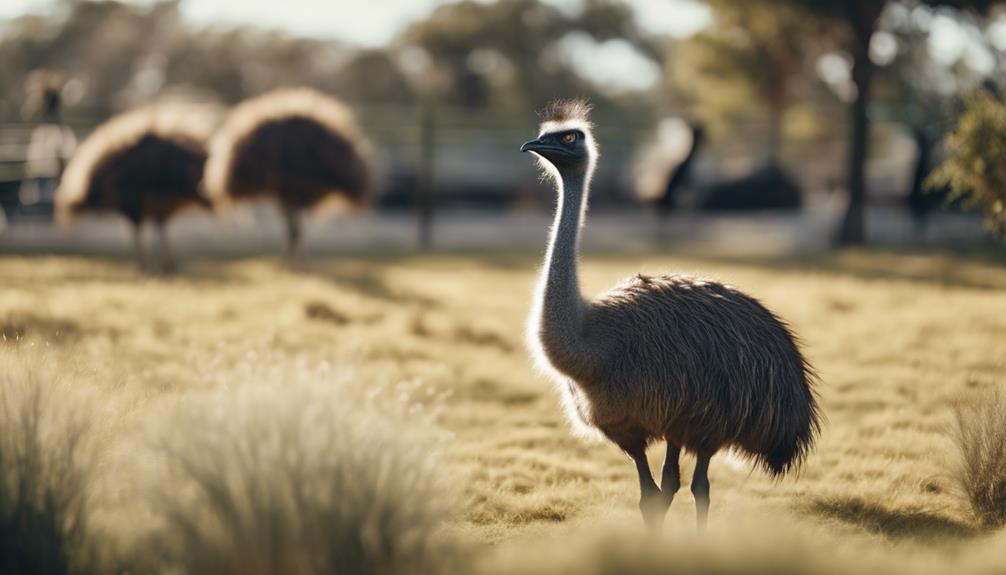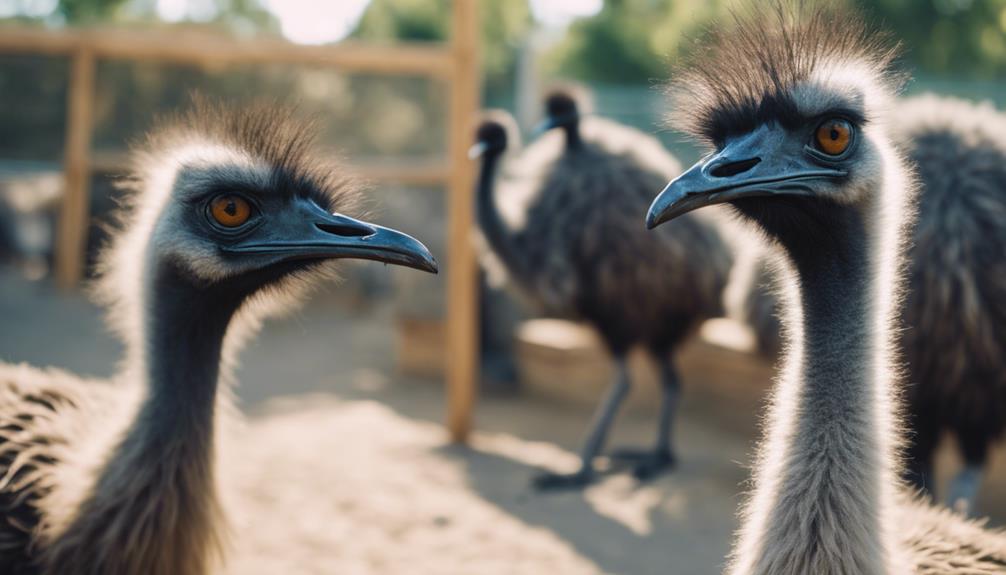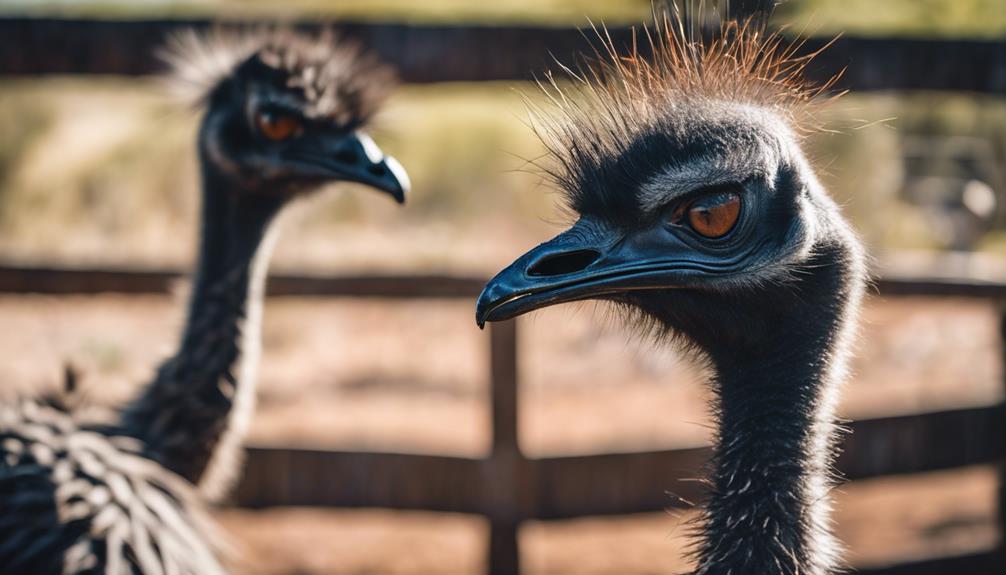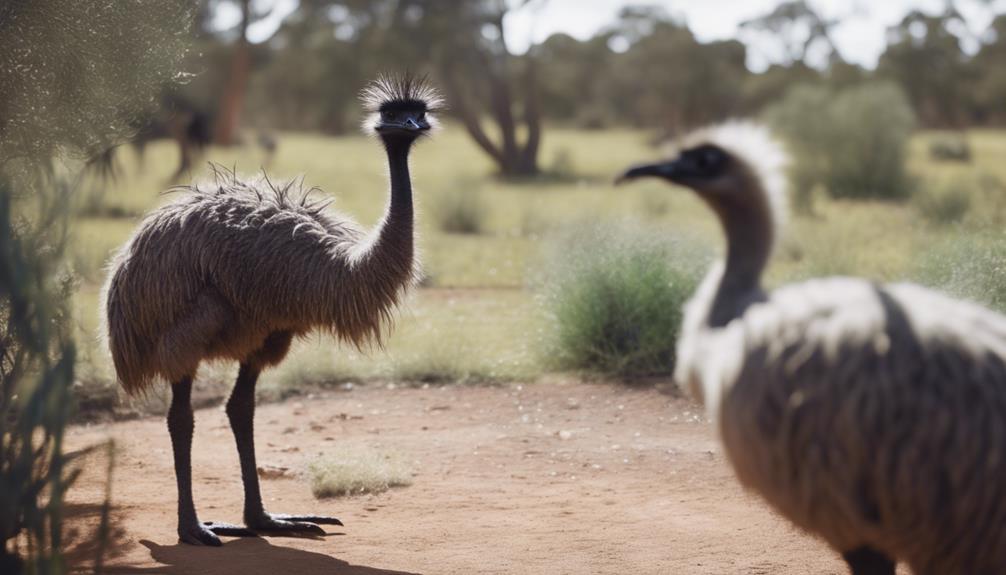
Imagine a vast landscape where emus roam freely, their majestic feathers glistening in the sunlight as they gracefully move across the terrain.
In contrast, emus in captivity often exhibit behaviors that may surprise you. The differences in their interactions, feeding habits, and adaptation to their environment raise intriguing questions about the impact of human influence on these fascinating creatures.
Explore the complexities of emu behavior in both captivity and the wild, and uncover the subtle nuances that shape their lives in unexpected ways.
Key Takeaways
- Captive emus exhibit altered social behaviors and limited diet compared to wild emus.
- Wild emus follow natural breeding seasons and exhibit stronger familial bonds.
- Habitat restrictions in captivity impact emus' exercise patterns and territorial behaviors.
- Human interaction in captivity affects emus' stress levels and nesting dynamics.
Emu Behavior Overview

When observing emu behavior, it becomes evident that these large flightless birds exhibit a wide range of complex social interactions and fascinating habits. Emus have intricate communication nuances, relying on a variety of vocalizations, body postures, and even feather movements to convey messages within their groups. In the wild, emus use these communication methods to establish hierarchies, warn others of danger, and attract potential mates.
However, behavioral changes in captivity can significantly impact emu interactions. When kept in confined spaces, emus may experience heightened stress levels, leading to alterations in their social behaviors. For example, captive emus may display increased aggression towards one another or exhibit repetitive movements as a manifestation of their frustration. These changes highlight the importance of providing adequate space and enrichment opportunities to ensure the well-being of emus in captivity.
Understanding these nuances in emu behavior is crucial for creating environments that support their natural social dynamics and overall welfare, whether in the wild or captivity.
Feeding Patterns Comparison
Emus in the wild and in captivity exhibit distinct differences in their feeding patterns, reflecting their adaptation to their respective environments. When it comes to feeding patterns, here are some key differences to consider:
- Feeding Frequency: In the wild, emus feed multiple times a day, constantly foraging for various plants, insects, and small vertebrates. In captivity, they're often fed on a more rigid schedule, with set feeding times that may not align with their natural feeding instincts.
- Habitat Preferences: Wild emus roam vast areas in search of food, adapting to different habitats based on seasonal changes. In contrast, captive emus have limited space to move around and may not have access to the same variety of plants and insects they'd find in the wild.
- Dietary Diversity and Seasonal Changes: Wild emus have a diverse diet that changes with the seasons, allowing them to meet their nutritional needs throughout the year. Captive emus may have a more limited diet, which can impact their overall health and behavior.
Understanding these differences in feeding patterns is crucial for providing optimal care for emus, whether they're in the wild or in captivity.
Social Interaction Variances

In examining social interaction variances between emus in the wild and those in captivity, notable distinctions become apparent. Emus in the wild exhibit intricate social bonding through various forms of communication such as vocalizations and body language. They rely on these mechanisms to establish group dynamics and hierarchy within their flocks, essential for survival in their natural habitat. Observing wild emus reveals a complex network of social interactions where individuals cooperate to protect each other and navigate their environment effectively.
On the other hand, emus in captivity often display altered social behaviors. Limited space and artificial environments can impact their social dynamics, leading to different hierarchy structures and communication patterns compared to their wild counterparts. Captive emus may struggle to establish natural social bonds, affecting their overall well-being and potentially causing stress.
Understanding these social interaction variances is crucial for ensuring the welfare of emus in captivity. Providing opportunities for natural socialization and enrichment activities can help mimic their wild social behaviors, promoting healthier interactions and overall happiness among captive emus.
Reproduction Varied Behaviors
Amidst the varied social interaction patterns exhibited by emus in captivity and the wild, a shift towards examining reproduction-related behaviors unveils intriguing insights into how these birds navigate their reproductive processes. When it comes to breeding habits, emus in captivity often display altered behaviors compared to their wild counterparts. In captivity, they may breed more frequently due to consistent access to food and suitable habitat conditions. On the other hand, wild emus tend to follow their natural breeding seasons, which are influenced by environmental factors such as temperature and food availability.
Habitat preferences also play a crucial role in emu reproduction. Captive emus may not have the same freedom to choose their preferred breeding grounds as wild emus do. This restriction can impact their breeding success and behavior. In the wild, emus meticulously select nesting sites that offer protection and resources essential for successful breeding. Understanding these differences in breeding habits and habitat preferences sheds light on the adaptive nature of emus in different environments.
Exercise and Movement Differences

Considering the distinct environments that emus in captivity and the wild navigate, differences in exercise and movement patterns become evident, highlighting the impact of habitat conditions on their physical activity levels. In the wild, emus have vast roaming opportunities, allowing them to engage in extensive exercise routines as they traverse diverse terrains in search of food and water. This freedom to move around contributes significantly to their overall physical health and agility.
On the contrary, emus in captivity face habitat restrictions that limit their roaming opportunities. These constraints often lead to altered exercise routines, as the space available is usually more confined compared to their natural habitats. Consequently, captive emus may exhibit reduced movement patterns and engage in less physical activity compared to their wild counterparts. This lack of freedom to roam extensively can impact their overall well-being, potentially affecting their muscle tone and overall physical fitness levels. It's crucial for caretakers of captive emus to provide adequate space and opportunities for exercise to mimic their natural behaviors as closely as possible.
Stress and Anxiety Levels
Transitioning from the impact of habitat conditions on exercise and movement patterns, the stress and anxiety levels experienced by emus in captivity compared to their wild counterparts reveal significant differences in their behavioral responses.
When considering Emu stress and behavior, it's essential to note that:
- Captive emus often exhibit higher stress levels due to limited space and social interactions, leading to behaviors like pacing and feather plucking.
- In contrast, wild emus experience stressors such as predators and food scarcity, prompting heightened vigilance and foraging strategies to survive.
- The comparison of anxiety levels highlights that captive emus may display repetitive behaviors like head-shaking or vocalizations, while wild emus showcase alertness and swift responses to potential threats in their environment.
Understanding these distinctions in Emu stress and anxiety levels provides valuable insights into how different environments can influence their psychological well-being and overall behavior.
Aggression and Territoriality

In examining Emu behavior, the dynamics of aggression and territoriality manifest distinctly between captive and wild environments. In the wild, Emus establish a dominance hierarchy through aggressive displays, such as pecking, chasing, and vocalizations. These behaviors are crucial for determining access to resources and mates, with dominant individuals asserting their control over territory through physical confrontations and displays of strength.
Territorial disputes among wild Emus often result in confrontations where individuals defend their space with vigor, using their size and strength to intimidate rivals. These conflicts can be intense, but they play a vital role in maintaining the structure of the group and establishing boundaries within their habitat.
On the other hand, Emus in captivity may exhibit reduced levels of aggression and territorial behavior due to the artificial setting and lack of competition for resources. Without the need to establish dominance or defend territory, captive Emus may display more docile behaviors, focusing instead on social interactions within their group. Despite these differences, the innate tendencies towards dominance hierarchy and territorial disputes remain fundamental aspects of Emu behavior, shaping their interactions and social structure in both captive and wild settings.
Vocalizations in Different Settings
Emus communicate through a diverse range of vocalizations that serve distinct purposes in both captivity and the wild, reflecting their social dynamics and environmental adaptations. In captivity, emus may exhibit altered vocalization patterns due to the artificial environment, while in the wild, their calls are finely attuned to the surrounding ecosystem.
- Communication differences: In captivity, emus may display vocalizations that are less frequent and varied compared to their wild counterparts. The limited space and interactions can impact the complexity of their calls.
- Environmental impact: Emus in the wild utilize their vocalizations to navigate vast landscapes, maintain social bonds, and warn of potential threats. These natural settings shape the nuances and purposes of their calls.
- Vocalization patterns, behavioral adaptations: The vocalization repertoire of emus in captivity may lack the richness and depth seen in wild emus. This difference can also influence their behavioral responses and adaptations to their surroundings, highlighting the importance of natural environments in fostering their communication skills.
Foraging Strategies Contrasts

Contrasting the foraging strategies of emus in captivity with those in the wild reveals distinct adaptations influenced by their environmental settings and social dynamics.
In captivity, emus exhibit different feeding behaviors compared to their wild counterparts. Captive emus, having a consistent food source provided, often display lower feeding efficiency as they can afford to be more selective. On the contrary, wild emus in their natural habitat must optimize feeding efficiency to survive. Their habitat preferences also play a crucial role; captive emus may not have the same variety of vegetation to choose from as those in the wild, impacting their foraging habits.
Moreover, predation risks and survival instincts further shape foraging strategies. Wild emus, constantly under threat from predators, tend to be more vigilant and efficient in their search for food. In contrast, captivity provides a safer environment, allowing for less urgency in foraging. Understanding these contrasts sheds light on how emus adapt their foraging behaviors based on their surroundings and the challenges they face in the wild versus captivity.
Nesting and Parenting Variances
Nesting and parenting behaviors in emus exhibit notable variations between captive and wild environments, reflecting adaptations influenced by their distinct habitats and social dynamics.
When observing emus in the wild, you may notice:
- Nesting Habits: In the wild, emus construct their nests in hidden spots to protect them from predators, showcasing their innate survival instincts.
- Communication: Wild emus use a range of vocalizations and body language to communicate with their mates and offspring, fostering strong familial bonds.
- Parenting Dynamics: Emus in the wild display a cooperative approach to parenting, with both male and female emus sharing the responsibilities of incubating eggs and caring for their young, showcasing a unique partnership in raising their offspring.
These variations highlight the intricate balance of nature's influence on emu behavior, shaping their nesting choices, communication styles, and parenting strategies based on the demands of their natural habitats and social structures.
Human Interaction Effects

The impact of human interaction on emu behavior in captivity versus the wild reveals nuanced shifts in nesting and parenting dynamics. In captivity, emus can benefit from training opportunities offered by humans. These training sessions can help acclimate emus to their environment, making it easier to handle them for health checks or other necessary care. However, excessive training can lead to stress and potential aggression in emus, affecting their overall well-being.
On the other hand, bonding opportunities with humans in captivity can foster a sense of trust between emus and their caretakers. This trust can be beneficial for the emus' overall welfare, as it can lead to easier handling and reduced stress levels. Nevertheless, there are risks involved in forming close bonds with emus, as it may lead to dependency issues or potential harm if the emus become too accustomed to human presence. Striking a balance between training benefits and drawbacks, as well as bonding opportunities and risks, is crucial in ensuring the well-being of emus in captivity.
Adaptation Challenges in Captivity
Amidst the confines of captivity, emus often face formidable hurdles when adapting to their new environment. These challenges can significantly impact their behavior and overall well-being. Here are some key points to consider:
- Behavioral Challenges: Emus in captivity may exhibit abnormal behaviors such as pacing, feather-plucking, or aggression. These behaviors are often a result of stress, boredom, or frustration from being confined to a limited space.
- Environmental Stimuli: The lack of natural environmental stimuli in captivity can be distressing for emus. In the wild, they've a vast territory to roam, forage for food, and socialize with other emus. In captivity, these stimuli are often limited, leading to behavioral issues.
- Social Interaction: Emus are highly social birds that thrive on interaction with their own kind. In captivity, they may experience loneliness and social isolation, which can lead to anxiety and depression.
Understanding and addressing these adaptation challenges are essential in providing emus with a suitable captive environment that promotes their natural behaviors and well-being.
Frequently Asked Questions
What Are Some Common Health Issues That Emus May Face in Captivity Compared to the Wild?
In captivity, emus may face health issues like obesity due to limited space for exercise and incorrect diet. Preventative care involves monitoring weight and providing proper nutrition. Dietary needs in captivity should mirror their wild foraging habits.
How Do Emus in Captivity Exhibit Boredom or Lack of Stimulation Compared to Their Wild Counterparts?
When emus lack stimulation in captivity, they may exhibit behaviors like pacing, feather-plucking, or even becoming lethargic. Emu enrichment programs can help alleviate boredom and encourage natural behaviors, as observed in behavioral studies.
Are There Any Differences in the Lifespan of Emus Kept in Captivity Versus Those in the Wild?
In captivity, emus tend to live longer due to controlled environments and access to consistent food and medical care. This can impact population dynamics by potentially increasing captive emu numbers compared to the wild where factors like predation come into play.
Do Emus in Captivity Show Any Signs of Depression or Other Mental Health Issues?
In captivity, emus may exhibit signs of depression or mental health issues due to lack of stimulation. Emu enrichment programs are vital to address their emotional well-being. Behavioral studies play a crucial role in understanding and enhancing emu welfare.
How Do Emus in Captivity Adapt to Artificial Environments and Different Climate Conditions Compared to Their Natural Habitats?
You may notice that emus in captivity face adaptation challenges when adjusting to artificial environments and varying climate conditions. Their ability to acclimate to these changes showcases their resilience and capacity for adjustment.
Conclusion
You have observed the stark differences between emu behavior in captivity and in the wild.
From feeding patterns to social interactions, reproduction behaviors to foraging strategies, the contrast is clear.
However, despite these variations, emus have shown remarkable adaptability in both environments.
Their ability to adjust and thrive in captivity while still maintaining their natural instincts in the wild is a testament to their resilience and evolutionary success.




